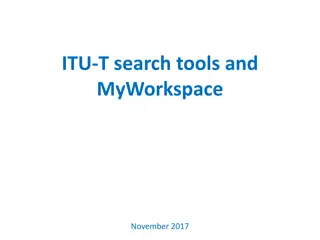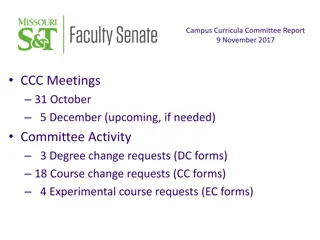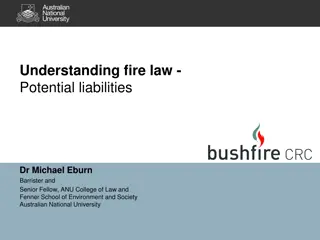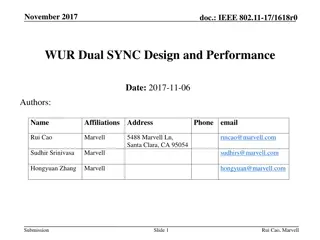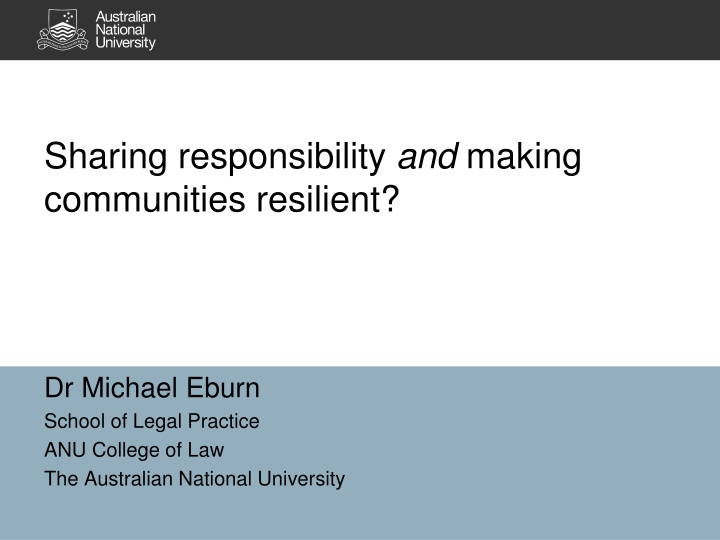
Building Resilient Communities: Sharing Responsibility and Managing Risks
Explore the concept of sharing responsibility and building resilient communities through the insightful perspectives of Dr. Michael Eburn. Delve into the complexities of risk assessment, balancing values, and resources. Understand the interplay between personal autonomy, community safety, and environmental considerations. Reflect on the costs, benefits, and challenges of enhancing community resilience in the face of natural disasters. Witness the discussions on individual resilience, emergency services dependence, and the measures of success and failure in disaster response efforts.
Download Presentation

Please find below an Image/Link to download the presentation.
The content on the website is provided AS IS for your information and personal use only. It may not be sold, licensed, or shared on other websites without obtaining consent from the author. If you encounter any issues during the download, it is possible that the publisher has removed the file from their server.
You are allowed to download the files provided on this website for personal or commercial use, subject to the condition that they are used lawfully. All files are the property of their respective owners.
The content on the website is provided AS IS for your information and personal use only. It may not be sold, licensed, or shared on other websites without obtaining consent from the author.
E N D
Presentation Transcript
Sharing responsibility and making communities resilient? Dr Michael Eburn School of Legal Practice ANU College of Law The Australian National University
Risk is not simply numbers Everything carries a risk. Determining what is an acceptable risk involves balancing values, interests and resources. 3
The common law values personal autonomy But expressed in the most general way, the value described as personal autonomy leaves it to the individual to decide whether to engage in conduct that may cause that individual harm. [o]n the whole people are entitled to act as they please, even if this will inevitably lead to their own death or injury . (Stuart v Kirkland-Veenstra (2009) 237 CLR 215) 4
There are competing interests Safety is not trumps. Individual v Community Community v Community. Environment 5
Resources What are the costs? What are the benefits? 6
How resilient is resilient enough? Brisbane after 2011 floods? Victoria after 2009 Black Saturday? The national capital during the 2003 fires? 8
Individual resilience If I call 132 500 for emergency help in flood, storm and tsunami is that evidence of resilience or dependence? Increased expectation of emergency services fueled by Actual capacity they normally do really well Social media and 24 hour news looking for the story 9
Whats success? Whats failure? 2011 Mitchell (ACT) fire Emergency alert reached 80% of the target land line audience, 63% of the target mobile phone recipients The press: Fire warning system fails Canberrans Mitchell Fire Alerts Failed ACT arsed up the use of emergency alerts during the Mitchell fire. 10
The alert Delivered 74 000 recorded and text messages; but failed to deliver 100 000. The belief that the emergency warning was a failure suggests that the popular view of shared responsibility is that it is the government s responsibility to tell people what to do and when and the communities responsibility to do what they are told. 11
The dilemma The more the emergency services can do, and the more they actually do, then the more they are expected to do. 12
The secondary risk experts who are being made increasingly accountable for what they do are now becoming more preoccupied with managing their own risks. Specifically, secondary risks to their reputation are becoming as significant as the primary risks for which experts have knowledge and training. 13
Whats to be done? start the serious debate about what risks individuals and communities are willing to accept, what price they will pay to meet their risk objectives, and what trade-offs they will accept. Those issues cannot be determined by professional risk or emergency managers because determining what risk, or price, is acceptable requires consideration of the full spectrum of values at stake, and those values are not just safety and economy. 14
Comments? Questions? References: MichaelEburn Bushfires and Australian emergency management law and policy: Adapting to climate change and the new fire and emergency management environment in Burton, L and Sun, L (eds) Cassandra s Curse: Law and Foreseeable Future Disasters (Studies in Law, Politics and Society; Elsevier, 2015); and Michael Eburn Should governments allow fire affected communities to rebuild? (2017) 16(4) Risk Frontiers Newsletter 2-4. 15
Thank you for your attention Michael Eburn P: 02 6125 6424 E: michael.eburn@anu.edu.au W: law.anu.edu.au/people/michael-eburn Blog: emergencylaw.wordpress.com 16

